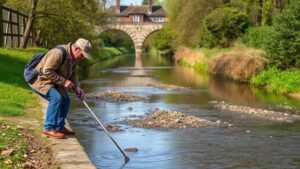Locating Evidence of Ancient Tool Repair Sites in Forest Groves
Locating Evidence of Ancient Tool Repair Sites in Forest Groves
The study of ancient tool repair sites presents a fascinating glimpse into prehistoric human behavior, technology, and resource management. Forest groves, with their rich biodiversity and often significant archaeological potential, serve as critical locations for locating such evidence. This article delves into the methods, tools, and significance of locating ancient tool repair sites within these verdant environments.
The Importance of Tool Repair in Prehistoric Cultures
Tool repair is an essential aspect of resource conservation and technological efficiency in ancient societies. Rather than continuously producing new tools, early humans adapted and maintained existing tools, which provided several advantages:
- Resource Conservation: Repairing tools minimizes material waste, a crucial practice in environments where raw materials may be limited.
- Skill Development: The act of repairing tools required specialized skills, showcasing the technological knowledge of ancient peoples.
- Cultural Continuity: Tools often had cultural significance, and their repairs could reflect the values and practices of a society.
The identification of tool repair sites can reveal insights into the technological transition from simple to more complex tools as societies evolved.
Identifying Potential Sites in Forest Groves
Forest groves provide a unique context for archeological exploration due to their ecological characteristics and the preservation of organic materials. Locating evidence of tool repair necessitates careful consideration of environmental factors, historical context, and methodological approaches. Potential sites can be identified through:
- Geological Surveys: Analysis of soil composition and layering can reveal past human activities through sediment cores and soil stratigraphy.
- Landscape Analysis: Features such as clearings, water sources, and natural shelters can indicate areas where ancient humans might have worked.
- Vegetation Patterns: Certain trees or plant species may suggest long-term human presence based on their growth patterns and the ecosystems they create.
For example, research conducted in the Amazon rainforest has shown that certain groves were frequently used for tool-making and repair based on the artifacts discovered and the surrounding environment.
Field Methods for Archaeological Surveys
To successfully uncover ancient tool repair sites, archaeologists employ a variety of field methods tailored to the forest environment:
- Surface Surveys: This method involves traversing the landscape to visually inspect and collect artifacts lying on the ground, often revealing tool fragments and debitage.
- Excavation: Systematic digging at identified locations can expose sub-surface artifacts and features, such as hearths or tool storage areas.
- Geophysical Techniques: Ground-penetrating radar and magnetometry can non-invasively detect anomalies in soil that may indicate historical human activity.
A notable example of successful field methods is the archaeological efforts in the Appalachian mountain range, where excavations revealed multiple layers of tool repair activities spanning several millennia.
Interpreting Findings from Tool Repair Sites
Once evidence of tool repair is located, interpreting the findings is paramount to understanding the broader context of human behavior. Key areas of analysis include:
- Artifact Analysis: Examination of the wear patterns and types of repairs can inform researchers about the tools’ functions and the technology used.
- Cultural Context: Understanding the cultural significance of tool repair practices can shed light on social structures and economic systems.
- Chronological Framework: Radiocarbon dating of organic materials found in conjunction with tools can provide a timeline for when these practices took place.
For example, a study conducted in Northern Europe analyzed stone tools that showed multiple instances of repair featuring distinctive patterns of usage and modifications, leading to theories about trade routes and cultural exchanges during the Mesolithic period.
Challenges in Locating and Researching Tool Repair Sites
Despite the potential for significant discoveries, several challenges complicate the research of tool repair sites in forest environments:
- Environmental Degradation: Natural processes like erosion, tree root growth, and animal activity can disrupt archaeological contexts.
- Access and Visibility: Dense vegetation may obscure potential sites, making identification and excavation difficult.
- Funding and Resource Allocation: Many archaeological endeavors rely on limited funding, impacting the scope of investigations.
Addressing these challenges requires ongoing collaboration with environmental scientists, improved reconnaissance techniques, and investment in conservation to protect and study these invaluable historical sites.
Conclusion
Locating evidence of ancient tool repair sites in forest groves offers critical insights into the resilience and innovation of early human societies. While challenges exist, the potential for rich archaeological discoveries underscores the importance of interdisciplinary research and methodology. As these ancient practices continue to be uncovered and understood, they contribute significantly to our knowledge of human technological evolution, cultural practices, and adaptability.
Future researchers are encouraged to develop targeted strategies for navigating the complexities of these environments, leveraging modern technological advances, and fostering collaboration across disciplines. By doing so, they can uncover the stories hidden within the forest groves, shedding light on the essential role of tool repair in the development of human civilization.



